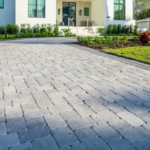Selecting the right paver pattern can completely transform the look and feel of your outdoor space. Whether you’re designing a driveway, patio, or walkway, the pattern you choose affects not only aesthetics but also durability and functionality. In this guide, we’ll explore how to pick the perfect paver pattern that matches your style, space, and practical needs.
Understand Your Space First
Before diving into patterns, look at the area you want to pave. Is it small or large? Straight or curved? The size and shape of your space will influence which paver patterns will work best.
For small areas, simple patterns can prevent the space from feeling cluttered. For large spaces, more intricate patterns create visual interest and make the area feel dynamic. Understanding your space is the first step to creating a stunning design.
Know Your Paver Options
Pavers come in different shapes, sizes, and materials, including concrete, brick, and natural stone. The paver type you choose affects which patterns are possible and how they will look.
For example, rectangular pavers are great for herringbone or basket weave patterns, while square or irregular-shaped pavers work well for more organic or random layouts. Matching your pattern to your paver type ensures a seamless, professional appearance.
Popular Paver Patterns to Consider
There are several patterns commonly used in landscaping projects:
- Herringbone: Strong and visually striking, perfect for driveways and high-traffic areas.
- Basket Weave: Creates a classic, timeless look, ideal for patios and walkways.
- Running Bond: Simple and elegant, suitable for almost any outdoor project.
- Circular or Radial Patterns: Adds a dramatic effect to patios or central garden areas.
Choosing the right pattern depends on both your aesthetic preference and the function of the area you’re paving.
Consider Traffic and Durability
Some paver patterns handle weight and wear better than others. For driveways or areas with heavy foot traffic, interlocking patterns like herringbone are recommended because they resist shifting.
In contrast, decorative patterns like circular designs may be best for low-traffic zones such as patios or garden paths. Balancing beauty and durability ensures your project remains functional for years to come.
Factor in Color and Texture
The color and texture of your pavers play a major role in the overall effect of the pattern. Contrasting colors can highlight intricate designs, while uniform colors create a clean, cohesive look.
Textured pavers add grip and prevent slipping, which is especially important for walkways or areas prone to moisture. Considering color and texture alongside your chosen pattern ensures your project is both safe and visually appealing.
Plan Your Layout Carefully
Sketch your layout before installation. Use paper or design software to see how the pattern fits the space. This allows you to make adjustments before cutting or laying pavers, saving time and money.
Don’t forget to consider borders—adding a contrasting edge can frame your pattern beautifully and give the installation a polished, professional appearance.
Installation Tips for Success
Proper installation is key to maintaining the pattern’s integrity. Start by preparing a solid base of gravel and sand, then carefully lay the pavers according to your design.
Use spacers or string lines to keep alignment consistent, especially for complex patterns. Once all pavers are in place, fill the joints with sand or polymeric sand to lock them securely. Well-laid pavers look great and last longer.
Maintain Your Paver Area
After installation, regular maintenance keeps your pavers looking fresh. Sweep away debris, rinse periodically, and refill joint sand if needed.
Sealing your pavers can also protect against stains and weathering. Proper maintenance preserves both the beauty and functionality of your pattern for years.
When to Seek Professional Help
If your project is large, complex, or involves high-traffic areas, hiring a professional ensures your paver pattern is installed correctly. Professionals can help with design advice, grading, and precise installation techniques.
For expert assistance in choosing and installing pavers, consider Lawn Care By Dan. Visit to learn more about their services, from planning to installation and maintenance.
FAQs
- Which paver pattern is best for driveways?
Herringbone is highly recommended for driveways because its interlocking design resists shifting under heavy loads. - Can I mix colors in a single paver pattern?
Yes! Mixing colors can highlight a pattern and add visual interest. Just make sure the colors complement each other and the surrounding landscape. - How do I choose a paver pattern for a small patio?
For smaller areas, simple patterns like running bond or basket weave are ideal—they create a clean look without overwhelming the space.

